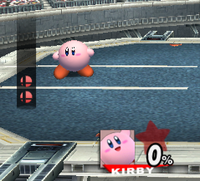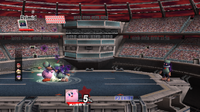Stock
Stock is the term the Super Smash Bros. series uses to describe what many other games call lives. In the Solo modes, such as Classic Mode, using up all the players' stocks brings them to the Game Over screen, where they may be offered the option to Continue. In Versus Mode, it describes the mode won on the basis of which player is KO'd the fewest number of times, either up to a maximum number or to a time limit.
In single-player modes
Classic Mode
Players can choose to begin with between one and five stocks, with three as the default number. This cannot be increased after starting and before quitting or receiving a "Game Over", although their damage percentage resets between matches as well as after using up a stock. Stocks remaining are displayed as small icons-icons of their character's face (in SSB, Melee, and SSB4) or dots (in Brawl) above the damage percentage. If the player can complete the mode without losing a single life, they will receive a bonus, whose value varies depending on the game.
Self-destructing in the Bonus Stages of Classic Mode does not cost the player a stock, nor does it count for the loss of the No-Miss Clear bonus.
Will the player use up all of their stock, then the option is given to allow a Continue. If the player chooses "No", then the game ends, and the player is sent back to the Character Select screen. If the player chooses "Yes", then the game restarts at the stage that they were KO'd in. However, the player's score is cut in half, and in Melee and Brawl, the player must pay a small compensation price with coins they have collected. The amount varies on the difficulty; higher difficulties require more coins. Additionally, in all three games, the player is given a significant point deduction of 20000 points for continuing.
All-Star Mode
Each player has only one stock to complete the entire mode, with their damage percentage carrying over between matches, although they can use up to three Heart Containers (five in two-player mode) which lie in the All-Star Rest Area to help maintain their single stock.
Continues function the same way in this mode as they do in Classic Mode.
Adventure Mode (Super Smash Bros. Melee)
The player can choose their number of stocks (one to five only), similar to Classic Mode.
Continues also function the same way in this mode as in Classic Mode and All-Star Mode.
The Subspace Emissary (Super Smash Bros. Brawl)
Players are assigned a set number of stocks to complete a level, which they can supplement by finding Stock Balls. This does not carry over between levels.
Stock count is displayed on the left-hand side of the screen, as a head icon of each character remaining in their current party. In the event of the player holding more stocks than their current party size, the headshots are supplemented by Smash Bros. icons and the order of play repeats (i.e., a player with five stocks and a party consisting of, in order, Mario, Link, Samus and Donkey Kong would automatically use Mario again on their fifth stock.) This can only occur if the player has fewer characters available to choose from for their party than the number of stocks for the level or if they pick up a Stock Ball during it - players cannot choose one character to be placed in two spots in the order. If a second player enters a game in progress, they use up one of the available stocks and take the next character in the sequence - this means that if player 1 has no spare stocks, the second player cannot join.
When a player reaches a cutscene and is at the point where the player can select what characters to play as in their party, their stock is reset to the default number. After the level is completed, replays do not play these cutscenes, which can significantly reduce the number of stocks a player has to complete the level and thus substantially increases the difficulty of replaying long levels such as The Subspace Bomb Factory II.
In the event of a player losing all their stocks, they are sent to the Continue screen.
Event matches
The amount of stock given to the player varies from event to event; they are displayed in the same way as Classic Mode.
Stadium
The Stadium encompasses the following modes, which vary in the amount of stock given.
Target Test/Smash!!
This mode grants the player only one stock.
Home-Run Contest
Home-Run Contest does not use stocks, as it is impossible to get KO'd in the mode.
Multi-Man mode
All versions of Multi-Man Melee in Melee and Brawl have the player use only one stock.
Boss Battles Mode
Gets one stock in a similar way to All-Star Mode, including damage carrying over between matches and Heart Containers in the Rest Area, but without the option to Continue after dying and using up your stock.
Training Mode
Training mode does not use stocks, as the mode operates via a never-ending Time match.
In versus modes
Stock is a mode that is playable in versus mode. It can be chosen from one to 99 lives. In this, the game acts as a "last man standing" game, where a player/team wins once all the other players/teams have lost all of their stocks. If a time limit is set in addition, then the player who has the most stocks remaining (with players tied for the most remaining stocks going to Sudden Death to settle the tie) wins. However, in most major tournaments, such a Sudden Death tiebreaker is normally ignored, and in that case the player who ended with the lowest damage percentage wins, with other pre-determinded tiebreaking methods used if there is a tie both for stocks and damage percentage at the end of the match. As with all modes, a player who has lost all their stocks cannot participate in the match, and can only merely watch. However, it is possible to share stock, allowing fallen teammates to take stocks from an active team member should they have at least one extra in reserve. While time mode is the default setting of the game, in tournaments and most serious matches, the mode is set to stock match due to the orderly, set fashion that it creates (though a time limit, usually of eight to ten minutes, is used to prevent a player from camping infinitely, and encourages players to approach). The standard number of stocks that are set in tournament matches are five for Smash 64, four for Melee and three for Brawl. The number of stocks is due to gameplay differences between the three games; Smash 64 has many ways for players to create 0-death combos with nearly every character in the game, and Melee, while not as combo-heavy as the original due to reduced hitstun and the introduction of Directional influence, is generally faster paced, resulting in a shorter amount of time for players in these two games to be KOed; in Brawl, KOs occur more slowly due to the lack of true combos at higher percents and generally slower movement speed. In fact, the slower pace of Brawl can be so taxing on the players and spectators that some Brawl tournaments use a format for one stock, three minute matches, as a rarely seen "tiebreaker" match would normally be in other formats.
In the Smash community, there are terms used to describe the margin of victory a player wins by. The term "X-stocked the opponent" is used to describe the number of stocks a winner ended a match with, where X is the number of stocks the winning player has. For example, a two-stock victory means that the victor defeated their opponent with two stocks remaining at the end of a match.
JV
The term "JV" refers to winning with a fresh stock at 0% damage; for example, a "JV two-stock" means the victor defeated their opponent with one stock remaining at 0% damage, referencing that the winner was only one hit away from a two-stock. This is often used for varying levels of bragging rights for skill. For example, three-stocking an opponent shows a greater difference of skill than if the player "merely" two-stocked them. Furthermore, a "JV five/four-stock" (winning with all four/three stocks remaining without taking any damage in Melee and Brawl, respectively) is considered a perfect game, and successfully performing one shows an extreme difference in skill level or incredible ability of the winner to perfectly read the loser's actions, as the loser failed to land even a single hit on the opponent.
A variation of "JV" is the "Freshman", where a player wins with 40% damage or less on their currrent stock. For example, if a player has three stocks remaining, but has 30% damage on their character, it is considered a "Freshman four-stock".
| Super Smash Bros. Brawl menu items | |
|---|---|
| Group | Brawl (Time · Stock · Coin Battle · Team Battle) · Rules · Special Brawl · Rotation · Tourney · Names |
| Solo | Classic · All-Star · Adventure Mode: The Subspace Emissary · Events · Stadium (Target Smash!! · Home-Run Contest · Multi-Man Brawl · Boss Battles) · Training |
| Wi-Fi | Spectator Mode · With Anyone · With Friends |
| Vault | Trophies & Stickers (Trophy Gallery · Trophy Hoard · Coin Launcher · Sticker Album · Sticker Center) · Stage Builder · Album · Challenges · Replays · Masterpieces · Chronicle |
| Options | Screen · Deflicker · Rumble · Controls · Sound · My Music · Erase Data |
| Data | Movies · Records (Group Records · Brawl Records · Notices) · Sound Test |

